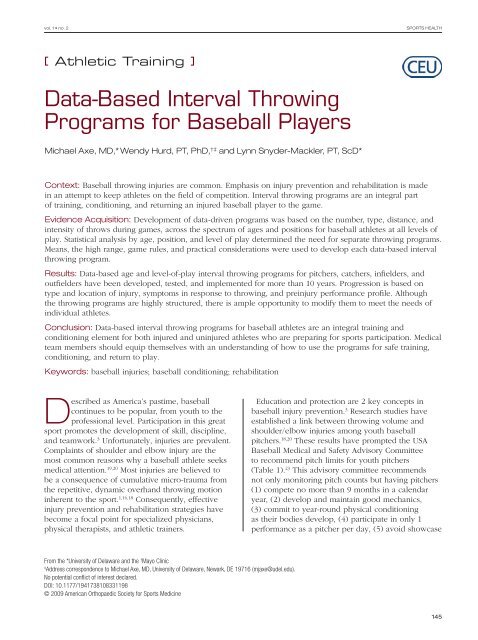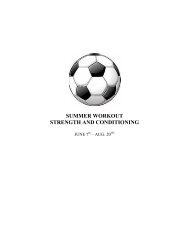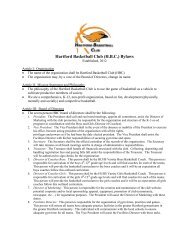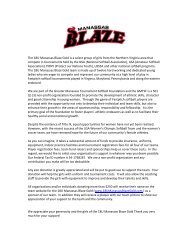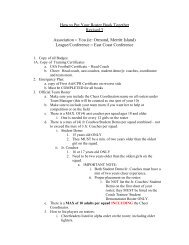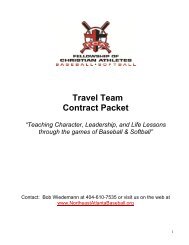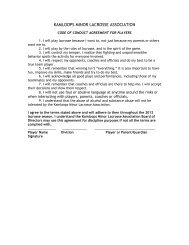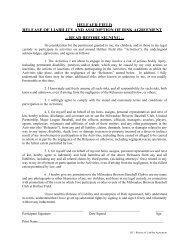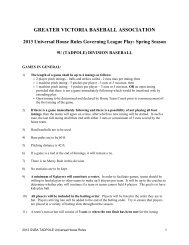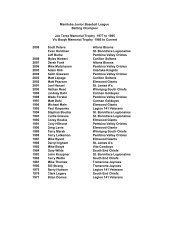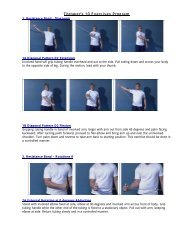Interval Throwing Program - BallCharts.com
Interval Throwing Program - BallCharts.com
Interval Throwing Program - BallCharts.com
Create successful ePaper yourself
Turn your PDF publications into a flip-book with our unique Google optimized e-Paper software.
vol. 1 • no. 2<br />
SPORTS HEALTH<br />
[ Athletic Training ]<br />
Data-Based <strong>Interval</strong> <strong>Throwing</strong><br />
<strong>Program</strong>s for Baseball Players<br />
Michael Axe, MD,* Wendy Hurd, PT, PhD, †‡ and Lynn Snyder-Mackler, PT, ScD*<br />
Context: Baseball throwing injuries are <strong>com</strong>mon. Emphasis on injury prevention and rehabilitation is made<br />
in an attempt to keep athletes on the field of <strong>com</strong>petition. <strong>Interval</strong> throwing programs are an integral part<br />
of training, conditioning, and returning an injured baseball player to the game.<br />
Evidence Acquisition: Development of data-driven programs was based on the number, type, distance, and<br />
intensity of throws during games, across the spectrum of ages and positions for baseball athletes at all levels of<br />
play. Statistical analysis by age, position, and level of play determined the need for separate throwing programs.<br />
Means, the high range, game rules, and practical considerations were used to develop each data-based interval<br />
throwing program.<br />
Results: Data-based age and level-of-play interval throwing programs for pitchers, catchers, infielders, and<br />
outfielders have been developed, tested, and implemented for more than 10 years. Progression is based on<br />
type and location of injury, symptoms in response to throwing, and preinjury performance profile. Although<br />
the throwing programs are highly structured, there is ample opportunity to modify them to meet the needs of<br />
individual athletes.<br />
Conclusion: Data-based interval throwing programs for baseball athletes are an integral training and<br />
conditioning element for both injured and uninjured athletes who are preparing for sports participation. Medical<br />
team members should equip themselves with an understanding of how to use the programs for safe training,<br />
conditioning, and return to play.<br />
Keywords: baseball injuries; baseball conditioning; rehabilitation<br />
Described as America’s pastime, baseball<br />
continues to be popular, from youth to the<br />
professional level. Participation in this great<br />
sport promotes the development of skill, discipline,<br />
and teamwork. 3 Unfortunately, injuries are prevalent.<br />
Complaints of shoulder and elbow injury are the<br />
most <strong>com</strong>mon reasons why a baseball athlete seeks<br />
medical attention. 19,20 Most injuries are believed to<br />
be a consequence of cumulative micro-trauma from<br />
the repetitive, dynamic overhand throwing motion<br />
inherent to the sport. 1,16,18 Consequently, effective<br />
injury prevention and rehabilitation strategies have<br />
be<strong>com</strong>e a focal point for specialized physicians,<br />
physical therapists, and athletic trainers.<br />
Education and protection are 2 key concepts in<br />
baseball injury prevention. 3 Research studies have<br />
established a link between throwing volume and<br />
shoulder/elbow injuries among youth baseball<br />
pitchers. 18,20 These results have prompted the USA<br />
Baseball Medical and Safety Advisory Committee<br />
to re<strong>com</strong>mend pitch limits for youth pitchers<br />
(Table 1). 23 This advisory <strong>com</strong>mittee re<strong>com</strong>mends<br />
not only monitoring pitch counts but having pitchers<br />
(1) <strong>com</strong>pete no more than 9 months in a calendar<br />
year, (2) develop and maintain good mechanics,<br />
(3) <strong>com</strong>mit to year-round physical conditioning<br />
as their bodies develop, (4) participate in only 1<br />
performance as a pitcher per day, (5) avoid showcase<br />
From the *University of Delaware and the † Mayo Clinic<br />
‡<br />
Address correspondence to Michael Axe, MD, University of Delaware, Newark, DE 19716 (mjaxe@udel.edu).<br />
No potential confl ict of interest declared.<br />
DOI: 10.1177/1941738108331198<br />
© 2009 American Orthopaedic Society for Sports Medicine<br />
145
Axe et al Mar • Apr 2009<br />
participation, and (6) limit participation to 1 team<br />
per season. 23 These re<strong>com</strong>mendations have also<br />
prompted the largest youth baseball league to<br />
institute rule changes based on pitch counts and<br />
types. Although further research is necessary to<br />
determine the consequences of throwing breaking<br />
pitches before physical maturity, the <strong>com</strong>mittee did<br />
report that throwing curves and sliders, with poor<br />
mechanics, appears to increase the risk of injury. 23<br />
Young athletes who can throw much further and<br />
faster than what age norms dictate are at risk for<br />
shoulder and elbow injuries. In a study of more than<br />
750 youth baseball players, normative data were<br />
established to categorize and monitor young pitchers<br />
(Table 2). 3 If athletes are more than 3 standard<br />
deviations above their peers for speed or distance,<br />
then they are in an exclusive group (26 of 10 000). If<br />
an athlete is 5 standard deviations above one’s peers,<br />
then he or she may truly be “one in a million.” The<br />
Table 1. USA Baseball pitch count re<strong>com</strong>mendations, by age. 23<br />
Age Group<br />
Pitches (n)<br />
9- to 10-year-olds 50 per game<br />
75 per week<br />
1000 per season<br />
2000 per year<br />
11- to 12-year-olds 75 per game<br />
100 per week<br />
1000 per season<br />
3000 per year<br />
13- to 14-year-olds 75 per game<br />
125 per week<br />
1000 per season<br />
3000 per year<br />
growth plates and the ligaments in this special group<br />
of players are of concern. Therefore, if an athlete is<br />
3 to 5 standard deviations in throwing velocity or<br />
distance beyond one’s peers, then 2 years should be<br />
subtracted from his or her actual age to determine<br />
appropriate pitching volume. For example, if an<br />
11-year-old male is 4 standard deviations above his<br />
peers for pitching velocity, then he should follow<br />
the pitch-limit re<strong>com</strong>mendations for a 9-year-old.<br />
Such special athletes can be identified as early as 8<br />
years of age. If not identified early, then these future<br />
superstars, whose growth plates may not be able to<br />
tolerate the forces and torques that they are able to<br />
generate, can potentially throw out their arms. 3<br />
Rehabilitation of the baseball athlete after injury<br />
has been well described. 2,11,17,21,24-27 Traditional<br />
nonoperative and postoperative rehabilitation<br />
programs for these patients involve a gradual<br />
restoration of range of motion, strength, muscular<br />
endurance, dynamic stabilization, and neuromuscular<br />
control. 24,26,27 Often omitted in the description of<br />
managing the injured baseball athlete is the transition<br />
from the clinic to the field. Traditional rehabilitation<br />
exercises cannot reproduce the speed or the joint<br />
forces generated during throwing. 6,13,14 The only<br />
way to mimic the forces of a baseball throw is to<br />
actually throw a ball. 6 <strong>Interval</strong> throwing programs<br />
are progressive, sport-specific regimens that<br />
gradually expose an athlete to the demands they will<br />
experience upon a return to sport.<br />
Although rehabilitation programs may re<strong>com</strong>mend<br />
participating in an interval throwing program<br />
before a return to <strong>com</strong>petition, 9,10 there are only a<br />
few published descriptions of throwing programs<br />
in peer-reviewed literature. 4-7,22 The forth<strong>com</strong>ing<br />
interval baseball-throwing programs have been<br />
derived from game data. The purpose of this clinical<br />
Table 2. Youth pitchers speed and distance: at-risk athletes. a<br />
Age (y) Average 1 SD 2 SD 3 SD 4 SD 5 SD<br />
mph feet mph feet mph feet mph feet mph feet mph feet<br />
8 40 95 43 109 47 123 50 137 54 151 57 165<br />
9 43 105 47 124 51 142 55 159 59 167 63 185<br />
10 46 123 50 140 54 157 58 174 62 174 66 191<br />
11 48 135 52 157 56 175 60 195 64 215 68 235<br />
12 50 141 55 166 60 191 65 216 70 241 75 266<br />
13 54 164 59 188 64 212 69 236 74 261 79 286<br />
14 60 196 66 225 72 254 78 283 84 312 90 341<br />
a<br />
Reprinted with permission by Lippincott Williams and Wilkins. 3 Three standard deviations (yellow), 26 athletes out of 10 000; 4 standard deviations (orange), 1 out<br />
of 100 000; 5 standard deviations (red), 1 out of 1 000 000.<br />
146
vol. 1 • no. 2<br />
SPORTS HEALTH<br />
<strong>com</strong>mentary is to provide a <strong>com</strong>plete set of databased<br />
interval throwing programs and progression<br />
instructions to aide the transitioning of injured<br />
and uninjured off-season baseball players back<br />
to the field. Furthermore, flexible <strong>com</strong>ponents<br />
of the interval throwing program can facilitate<br />
individualization. The assumption and expectation is<br />
that the pathomechanics leading to injury have been<br />
corrected before <strong>com</strong>mencing these programs.<br />
INTERVAL THROWING PROGRAM<br />
DEVELOPMENT AND DESIGN<br />
The goal with each throwing program is that<br />
upon <strong>com</strong>pletion, the athlete will be prepared for<br />
the workload encountered during <strong>com</strong>petition at<br />
one’s preinjury activity level, while minimizing<br />
the risk of reinjury. If not properly prepared, an<br />
athlete is vulnerable to injury upon return to sports<br />
participation. This is true whether the athlete has a<br />
throwing-arm injury, a nonthrowing-arm injury, or an<br />
injury to any region of the body that has resulted in<br />
lost playing time. Therefore, these position-specific<br />
interval programs, modified to one’s level of play, are<br />
not exclusive to baseball players with injuries of their<br />
throwing extremities.<br />
Likewise, the uninjured baseball player who<br />
is returning to play after an off-season must be<br />
prepared for practice. “Too much, too soon” can<br />
result in an onslaught of injuries for a team at the<br />
start of the preseason. Thus, interval throwing<br />
programs are an excellent training strategy for<br />
uninjured athletes to prepare for the new season,<br />
and they provide coaches with an easy reference for<br />
workouts.<br />
The major feature of these throwing programs is<br />
that they are data driven. Most interval programs<br />
are based merely on estimations of when an athlete<br />
should return to play. In this era of evidence-based<br />
medicine, it is important that treatment interventions<br />
be based on objective data, whenever possible.<br />
Each position-specific throwing program is based on<br />
game data and so represents a realistic workload that<br />
the athlete will experience upon a return to sports<br />
participation. This approach helps to ensure the<br />
athlete’s preparedness and thus minimize the risk of<br />
reinjury. As such, this program is practical, functional,<br />
and progressive.<br />
Practical<br />
First, equipment needs are minimal and inexpensive;<br />
only balls, a field, and a tape measure are needed. 23<br />
Second, the program design was intended to address<br />
the short attention span of young athletes; the<br />
time to <strong>com</strong>plete the program on any given day is<br />
approximately 45 minutes or less. The intervals that<br />
<strong>com</strong>pose each step of the throwing program allow<br />
constant reinforcement to improve <strong>com</strong>pliance and<br />
reduce boredom. Finally, the throwing programs are<br />
thoroughly outlined with detailed instructions for<br />
progression. Hopefully, excuses for non<strong>com</strong>pliance<br />
are reduced, and implementation by the athlete may<br />
be maximized. After initial instruction, supervision by<br />
an athletic trainer, a physical therapist, a physician, or<br />
any other member of the medical team might only be<br />
necessary to ensure that the athlete understands all<br />
instructions. 6<br />
Functional<br />
Functional throwing programs are ones that reflect<br />
the demands of the game. Differences in field<br />
dimensions and pitch-count limitations can vary<br />
considerably, depending on the athlete’s age and<br />
level of play. Furthermore, the number, intensity,<br />
and type of throws can vary by position. Therefore,<br />
it is reasonable to have age- and position-specific<br />
throwing programs to meet the needs of each<br />
athlete.<br />
Functional <strong>Interval</strong> <strong>Throwing</strong> <strong>Program</strong>s for<br />
Pitchers<br />
Game data were collected, including the number of<br />
innings pitched, the number of pitches per inning,<br />
the pitch mix, and the time between innings. 5,6 The<br />
full age spectrum of baseball <strong>com</strong>petitors were<br />
evaluated, including 8- to 12-year-olds, 13- to 14-yearolds,<br />
and high school, college, and professional<br />
players. The analysis revealed that the number of<br />
innings per outing and the number of pitches per<br />
inning for starters were different across groups,<br />
with the 8- to 12-year-old age group and the 13- to<br />
14-year-old age groups pitching significantly fewer<br />
innings per outing than the other 3 groups. 6 Although<br />
the pitching volume for both age groups was similar,<br />
the rules and field dimensions, <strong>com</strong>bined with the<br />
need to progress to the high school volume within<br />
2 years, rendered only 1 throwing program for 8- to<br />
12-year-olds ineffective in addressing the needs of<br />
the slightly older players. 6 Based on statistical analysis<br />
of these data, 3 throwing programs were developed:<br />
1 for pitchers 8 to 12 years old (Appendix 1 available<br />
online at http://sph.sagepub.<strong>com</strong>/content/suppl), 1<br />
for pitchers 13 to 14 years old, and 1 for high school,<br />
college, and professionals (Tables 3 and 4). 5,6<br />
The throwing programs must assist the athlete’s<br />
progress from inactivity in the off-season to throwing<br />
at game volume. To achieve this goal, the throwing<br />
programs are divided into 4 distinct and progressive<br />
phases: return to throwing, return to pitching,<br />
intensified pitching, and a simulated game. 6<br />
147
Axe et al Mar • Apr 2009<br />
Table 3. Pitcher throwing program for 13- to 14-year-olds. a<br />
Phase I Return to <strong>Throwing</strong> Phase II Return to Pitching<br />
All throws are at 50% effort<br />
Step 1 Warm up toss to 60´ Step 4 Warm-up toss to 105´<br />
15 throws at 30´* 20 fastballs (50%) *<br />
15 throws at 30´* 16 fastballs (50%) *<br />
15 throws at 30´ 16 fastballs (50%) *<br />
20 long tosses to 60´ 25 long tosses to 105´<br />
Step 2 Warm-up toss to 75´ Step 5 Warm-up toss to 120´<br />
15 throws at 45´* 20 fastballs (50%) *<br />
15 throws at 45´* 20 fastballs (50%) *<br />
15 throws at 45´ 20 fastballs (50%) *<br />
20 long tosses to 75´ 25 long tosses to 120´<br />
Step 3 Warm-up toss to 90´ Step 6 Warm-up toss to 120´<br />
15 throws at 60´* 16 fastballs (50%) *<br />
15 throws at 60´* 20 fastballs (50%) *<br />
15 throws at 60´ 20 fastballs (50%) *<br />
20 long tosses to 90´ 16 fastballs (50%) *<br />
Fastballs are from level ground following<br />
25 long tosses to 120´<br />
crow hop<br />
Phase III Intensifi ed Pitching<br />
Step 7 Warm-up toss to 120´ Step 11 (Active rest) Step 14 Warm-up toss to 120´<br />
20 fastballs (50%) * Warm-up toss to 120´ 20 fastballs (100%) *<br />
20 fastballs (75%) * 20 throws at 60´ (75%) Throws to 1st (100%)<br />
20 fastballs (75%) * 15 throws at 80´ (75%) 15 fastballs (100%) *<br />
20 fastballs (50%) * Step 12 20 throws at 60´ (75%) 10 off-speed pitches (100%) *<br />
25 long tosses to 160´ 15 throws at 80´ (75%) 20 fastballs (100%) *<br />
Step 8 Warm-up toss to 120´ 20 long tosses to 160´ 5 off-speed pitches (100%) *<br />
20 fastballs (75%) * Warm-up toss to 120´ 20 fastballs (75%) *<br />
21 fastballs (50%) * 20 fastballs (100%) * 5 throws to 1st (75%)<br />
20 fastballs (75%) * 20 fastballs (75%) * 25 long tosses to 160´<br />
21 fastballs (50%) * 6 off-speed pitches (75%) * Step 15 Batting practice<br />
25 long tosses to 160´ 20 fastballs (100%) * 100-110 pitches<br />
Step 9 Warm-up toss to 120´ Step 13 20 fastballs (75%) * 10 throws to 1st<br />
25 fastballs (50%) * 6 off-speed pitches (75%) * Bunts and <strong>com</strong>ebacks<br />
24 fastballs (75%) * 25 long tosses to 160´ Step 16 Simulated game<br />
24 fastballs (75%) * Warm-up toss to 120´<br />
25 fastballs (50%) * 20 fastballs (75%) *<br />
25 long tosses to 160´ 4 throws to 1st (75%)<br />
Step 10 Warm-up toss to 120´ 15 fastballs (100%) *<br />
25 fastballs (75%) * 10 off-speed pitches (100%) *<br />
25 fastballs (75%) * 20 fastballs (100%) *<br />
25 fastballs (75%) * 5 off-speed pitches (75%) *<br />
20 fastballs (75%) * 20 fastballs (75%) *<br />
25 long tosses to 160´ 4 throws to 1st (75%)<br />
25 long tosses to 160´<br />
a<br />
Reprinted with permission by Lippincott Williams and Wilkins. 6<br />
continued on next page<br />
148
vol. 1 • no. 2<br />
SPORTS HEALTH<br />
SIMULATED GAME<br />
1. 10 minutes warm-up of 50-80 pitches with gradually increasing velocity<br />
2. 5 innings<br />
3. 22-27 pitches per inning, including 15-20 fastballs<br />
4. 6 minutes rest between innings<br />
*<br />
Rest 6 minutes after these sets.<br />
INSTRUCTIONS<br />
A. Baseline/preseason<br />
To establish a base for training and conditioning, begin with step 3 and advance one step daily to step 14 following soreness rules.<br />
B. Nonthrowing arm injury<br />
After medical clearance, begin step 3 and advance one step daily to step 16 following soreness rules.<br />
C. <strong>Throwing</strong> arm—bruise or bone involvement<br />
After medical clearance, begin with step 1 and advance program as soreness rules allow throwing no more than every other day.<br />
D. <strong>Throwing</strong> arm—tendon/ligament injury (mild)<br />
• After medical clearance, begin with step 1 and advance program to step 3 throwing every other day as soreness rules allow.<br />
• Throw every third day on steps 4-8 as soreness rules allow.<br />
• Return to throwing every other day as soreness rules allow for steps 9-16.<br />
E. <strong>Throwing</strong> arm—tendon/ligament injury (moderate, severe, or post op)<br />
• After medical clearance, begin throwing at step 1.<br />
• For steps 1-3, advance no more than 1 step every 3 days with 2 days of active rest (warm-up and long tosses) following each workout.<br />
• Steps 4-8 advance no more than 1 step every 3 days with 2 days active rest (see step 11) following each workout.<br />
• Advance steps 9-16 daily as soreness rules allow.<br />
Table 4. <strong>Throwing</strong> program for high school, college, and professional baseball pitchers. a<br />
Phase I Return to <strong>Throwing</strong> Phase II Return to Pitching †<br />
All throws are at 50% effort<br />
Step 1 Warm-up toss to 60´ Step 8 15 throws at 60´6´´ (75%) *<br />
15 throws at 30´* 20 throws at 60´6´´ (75%) *<br />
15 throws at 30´* 20 throws at 60´6´´ (75%) *<br />
15 throws at 30´ 15 throws at 60´6´´ (75%) *<br />
20 long tosses to 60´ Step 9 20 throws at 60´6´´ (75%) *<br />
Step 2 Warm-up toss to 75´ 20 throws at 60´6´´ (75%) *<br />
15 throws at 45´* 20 throws at 60´6´´ (75%) *<br />
15 throws at 45´* 20 throws at 60´6´´ (75%) *<br />
15 throws at 45´ Step 10 20 fastballs (50%) *<br />
20 long tosses to 75´ 20 fastballs (50%) *<br />
Step 3 Warm-up toss to 90´ 20 fastballs (50%) *<br />
15 throws at 60´* 20 fastballs (50%) *<br />
15 throws at 60´* 25 throws at 60´6´´ (75%) *<br />
15 throws at 60´ Step 11 20 fastballs (50%) *<br />
20 long tosses to 90´ 20 fastballs (75%) *<br />
Step 4 Warm-up toss to 105´ 20 fastballs (50%) *<br />
15 throws at 75´* 15 fastballs (75%) *<br />
15 throws at 75´* 25 throws at 60´6´´ (75%) *<br />
15 throws at 75´*<br />
20 long tosses to 105´<br />
continued on next page<br />
149
Axe et al Mar • Apr 2009<br />
Phase I Return to <strong>Throwing</strong> Phase II Return to Pitching †<br />
Step 5 Warm-up toss to 120´ Step 12 25 fastballs (50%) *<br />
15 throws at 90´* 20 fastballs (75%) *<br />
20 throws at 90´* 20 fastballs (75%) *<br />
15 throws at 90´* 20 fastballs (75%) *<br />
20 long tosses to 120´ 20 fastballs (75%) *<br />
Step 6 Warm-up toss to 120´<br />
20 throws at 105´*<br />
20 throws at 105´*<br />
15 throws at 105´*<br />
20 long tosses to 120´<br />
Step 7 Warm-up toss to 120´<br />
20 throws at 120´*<br />
20 throws at 120´*<br />
20 throws at 120´*<br />
20 long tosses to 120´<br />
Throws at effort level given<br />
Phase III Intensifi ed Pitching ‡<br />
Step 13 25 fastballs (75%) * Step 16 20 fastballs (100%) * Step 18 (Active rest)<br />
20 fastballs (100%) * 15 fastballs (100%) Repeat step 14<br />
10 fastballs (75%) * 5 off-speed pitches Step 19 20 fastballs (100%)<br />
15 fastballs (100%) * 5 pickoff throws to 1st 5 off-speed pitches *<br />
25 fastballs (75%) * 20 fastballs (100%) 20 fastballs (100%)<br />
Step 14 (Active Rest) 5 off-speed pitches * 3 pickoff throws to 1st *<br />
20 throws at 80´ 20 fastballs (100%) 20 fastballs (100%)<br />
20 throws at 80´ 5 off-speed pitches * 3 pickoff throws to 2nd *<br />
20 throws at 80´ Step 17 15 fastballs (100%) 15 fastballs (100%)<br />
20 throws at 80´ 5 off-speed pitches * 5 off-speed pitches *<br />
Step 15 20 fastballs (75%) * 15 fastballs (100%) 15 fastballs (100%)<br />
20 fastballs (100%) 3 pickoff throws to 1st * 5 off-speed pitches *<br />
5 off-speed pitches * 20 fastballs (100%) Step 20 Batting practice<br />
15 fastballs (100%) 5 off-speed pitches * 110-120 pitches<br />
5 off-speed pitches * 15 fastballs (100%) Field bunts and <strong>com</strong>ebacks<br />
20 fastballs (100%) 3 pickoff throws to 2nd * Step 21 Simulated game<br />
5 off-speed pitches * 15 fastballs (100%)<br />
Field bunts and <strong>com</strong>bebacks 5 off-speed pitches *<br />
a<br />
Reprinted with permission by Lippincott Williams and Wilkins. 6<br />
*Rest 9 minutes after these sets.<br />
†<br />
Begin steps in this phase with warm-up toss to 120´. All fastballs are from level ground after a crow hop. Finish steps in this phase with 25 long tosses to 160´.<br />
‡<br />
Begin all steps in this phase with warm-up toss to 120´. Finish steps in this phase with 25 long tosses to 160´.<br />
**Relievers and closing pitchers can go to step 21 on the next throwing day after <strong>com</strong>pleting this step<br />
SIMULATED GAME<br />
1. 10 minutes warm-up of 50-80 pitches with gradually increasing velocity.<br />
2. 5-8 innings for starters, 3-5 innings for relievers, 2-3 innings for closers.<br />
3. 15-20 pitches per inning, including 10-15 fastballs<br />
4. 9 minutes rest between innings<br />
continued on next page<br />
150
vol. 1 • no. 2<br />
SPORTS HEALTH<br />
INSTRUCTIONS<br />
A. Baseline/preseason<br />
To establish a base for training and conditioning, begin with step 4 and advance one step daily following soreness rules.<br />
B. Nonthrowing arm injury<br />
After medical clearance, begin step 4 and advance one step daily following soreness rules.<br />
C. <strong>Throwing</strong> arm—bruise or bone involvement<br />
After medical clearance, begin with step 1 and advance program as soreness rules allow throwing every other day.<br />
D. <strong>Throwing</strong> arm—tendon/ligament injury (mild)<br />
• After medical clearance, begin with step 1 and advance program to step 7 throwing every other day as soreness rules allow.<br />
• Throw every third day on steps 8-12 as soreness rules allow.<br />
• Return to throwing every other day as soreness rules allow for steps 13-21.<br />
E. <strong>Throwing</strong> arm—tendon/ligament injury (moderate, severe, or post op)<br />
• After medical clearance, begin throwing at step 1.<br />
• For steps 1-7, advance no more than 1 step every 3 days with 2 days of active rest (warm-up and long tosses) following each workout.<br />
• Steps 8-12 advance no more than 1 step every 3 days with 2 days active rest (see step 14) following each workout.<br />
• Steps 13-16 advance no more than 1 step every other day with 1 day active rest (see step 14) between steps.<br />
• Advance steps 17-21 daily as soreness rules allow.<br />
The amount of time required to <strong>com</strong>plete each<br />
phase of the throwing program is individualized<br />
and dictated by the type of injury that the athlete<br />
sustains as well as by any symptoms in response to<br />
throwing. The program begins with short throws at<br />
50% effort and with longer tosses from level ground,<br />
to build arm strength and endurance. Depending on<br />
the level of play, there are between 3 and 7 steps in<br />
the return-to-throwing phase. Once a base has been<br />
established, the pitcher progresses to pitching from<br />
level ground (2-5 steps), followed by advancement to<br />
the pitching mound (3-9 steps). Fastballs are thrown<br />
exclusively until the pitcher has advanced to 75%<br />
of the expected game volume. Then, the pitcher<br />
may begin incorporating off-speed pitches based on<br />
one’s preinjury pitch preference. After the athlete can<br />
<strong>com</strong>plete the final step of the intensified-pitching<br />
phase without soreness, the throwing program is<br />
culminated with a simulated game, to replicate the<br />
demands of <strong>com</strong>petition as accurately as possible. 5,6<br />
Short toss and long toss are 2 functional elements of<br />
each pitcher’s programs. The short-toss <strong>com</strong>ponent<br />
employs the principles of adaptation to imposed<br />
demands; that is, pitchers must pitch. 5 The longtoss<br />
<strong>com</strong>ponent, rather than reflecting the demands<br />
of pitching, is used to develop endurance and arm<br />
strength, reduce injuries, and increase speed. 5 A<br />
correlation of this concept would be running long<br />
distances to improve a sprinter’s performance and<br />
reduce injury. 5 For the 8- to 12-year-old throwing<br />
program, the maximum throwing distance for long<br />
toss is based on age and preinjury data. If only pitch<br />
speed and age are known, the long-toss maximum<br />
distance can be found in Appendix 1B available<br />
online at http://sph.sagepub.<strong>com</strong>/content/suppl.<br />
Functional <strong>Interval</strong> <strong>Throwing</strong> <strong>Program</strong>s for<br />
Position Players<br />
Game data were collected for the positional baseball<br />
player from 13 years old to college age to confirm<br />
whether position- and/or age-specific interval<br />
throwing programs were necessary for these athletes. 7<br />
For catchers, the following data were recorded: the<br />
number of throws back to the pitcher (60 ft, 6 in),<br />
the number of sprints to back up plays at 1st or 3rd<br />
base (90 ft), the time in the squat stance, the number<br />
of throws other than throws back to the pitcher, the<br />
distance of these throws, and the perceived effort of<br />
these throws. Infielder and outfielder data included<br />
the number of throws, the distance of the throws, and<br />
the data collector’s perception of each throw effort.<br />
The means and ranges per inning and per game were<br />
then calculated for each variable of interest.<br />
These data were subsequently used to determine<br />
which age and position programs were necessary and<br />
to construct the throwing programs. Statistical analysis<br />
revealed no significant differences across age groups<br />
for either catchers or infielders. 7 Consequently, there<br />
are only position-specific throwing programs for these<br />
athletes (see Appendices 2 and 3 available online at<br />
http://sph.sagepub.<strong>com</strong>/content/suppl.). 7 Position- and<br />
age-specific programs were not needed. There were,<br />
however, significant differences among outfielders,<br />
which subsequently necessitated age-specific programs<br />
for the outfield position. The 13-year-old outfielders<br />
had mean throwing distances and high ends of<br />
151
Axe et al Mar • Apr 2009<br />
throwing distance range that were significantly lower<br />
than those the other levels of players. 7 Therefore,<br />
separate outfielder programs were developed for<br />
13-year-olds and adults (see Appendix 4 available<br />
online at http://sph.sagepub.<strong>com</strong>/content/suppl.).<br />
Progressive<br />
Each throwing program is, by design, progressive. A<br />
<strong>com</strong>bination of the number, intensity, distance, and<br />
rest time between throws, as well as the type of pitch<br />
thrown (when appropriate), advances from step to<br />
step. The initiation of throwing for the injured baseball<br />
player must be based on the assumption that tissue<br />
healing is <strong>com</strong>plete, that the athlete has appropriately<br />
progressed with the exercise program, and that a<br />
satisfactory clinical examination has been conducted<br />
(including range of motion, strength, joint stability,<br />
and pain resolution). Once the athlete initiates the<br />
throwing program, the medical team must educate the<br />
athlete on the importance of following the structured<br />
progression. A study by Fleisig et al 15 illustrated the<br />
athlete’s flawed ability to estimate throwing effort. In<br />
a study of healthy pitchers targeting a 50% effort, the<br />
athletes generated ball speeds of 85% and forces and<br />
torques approaching 75% of maximum. 15 A target of<br />
75% effort achieved speeds of 90% and forces and<br />
torques of 85% of maximum. 15<br />
Advancement through each throwing program is<br />
governed by the type of injury that the athlete has<br />
encountered and the soreness rules (Table 5). 5-7<br />
The exception is the uninjured athlete who is<br />
participating in a throwing program as part of one’s<br />
preseason preparation. In these instances, progression<br />
is dictated by only the soreness rules. 6,7 The type of<br />
injury guides program progression. Categories include<br />
injuries to areas of the body other than the throwing<br />
arm (eg., back, nonthrowing arm), injuries to the<br />
throwing arm but not including the joints (eg., bruise),<br />
tendonitis, and joint injuries (eg., rotator cuff tear,<br />
postoperatively). 6,7 These categories determine at which<br />
level the athlete may initiate the throwing program<br />
and how quickly progression may occur. The soreness<br />
rules guide progression within the throwing program<br />
on the basis of an athlete’s symptoms. 5-7 Although there<br />
are general time frames for tissue healing, the health<br />
care provider must be attentive to individual variability<br />
in healing rates. Consequently, progression within the<br />
throwing program must be individualized. Given the<br />
timing and duration of the symptoms, the medical team<br />
may be able to minimize the risk of overloading injured<br />
tissues, by determining whether a baseball player is<br />
ready to progress to the next step, remain at the same<br />
step, or drop down a step. In addition, the soreness<br />
rules, along with the type of injury, dictate the amount<br />
of rest time between steps. 6,7<br />
Table 5. Soreness rules, all players. a<br />
If no soreness, advance one step every throwing day.<br />
If sore during warm-up but soreness is gone within the fi rst 15 throws, repeat<br />
the previous workout. If shoulder be<strong>com</strong>es sore during this workout, stop and<br />
take 2 days off. Upon return to throwing, drop down one step.<br />
If sore more than 1 hour after throwing, or the next day, take 1 day off and repeat<br />
the most recent throwing program workout.<br />
If sore during warm-up and soreness continues through the fi rst 15 throws, stop<br />
throwing and take 2 days off. Upon return to throwing, drop down one step.<br />
a<br />
Reprinted with permission by Lippincott Williams and Wilkins. 5-7<br />
The final step of most throwing programs is a<br />
simulated game for a given position at the maximum<br />
level of play. A true simulated game is derived<br />
from actual game data. 8 Coleman et al 12 collected<br />
3 years of data and suggested a game simulation<br />
for professional pitchers that controlled for innings<br />
pitched, pitches per inning, time between innings,<br />
and preinjury pitch mix. The goal was to determine<br />
a pitcher’s readiness to return after injury. Although<br />
Coleman’s simulated game is a good tool for<br />
establishing game readiness, it did not include a<br />
functional progression toward return to play, nor<br />
did it address the demands faced by positional<br />
baseball players or by athletes <strong>com</strong>peting below<br />
the professional level. 7 The <strong>com</strong>bination of ageand<br />
position-specific throwing programs, together<br />
with simulated games, may be used as criteria to<br />
determine return-to-play readiness. 7<br />
INDIVIDUALIZATION<br />
Data-based throwing programs that have been<br />
customized to meet the needs of the individual<br />
have the greatest potential to return the baseball<br />
athlete to one’s preinjury activities, expeditiously<br />
and safely. Many characteristics of the data-driven<br />
programs promote individualization: age- and<br />
position-appropriate programs, progression rate<br />
based on the type of injury and the soreness rules,<br />
and pitch mixes based on preinjury preferences.<br />
The throwing program for the 8- to 12-year-old<br />
pitcher is an excellent example of an individualized<br />
program, given that the long-toss portion of<br />
the program is based on the athlete’s age and<br />
preinjury pitching velocity or maximum distance<br />
thrown. There is, however, ample opportunity for<br />
the medical team to further individualize these<br />
throwing programs.<br />
Collection of preinjury data is the best method to<br />
develop a performance profile and so individualize<br />
a throwing program. To develop the programs<br />
152
vol. 1 • no. 2<br />
SPORTS HEALTH<br />
described, data from large sample sizes were<br />
collected, tested, and implemented for baseball<br />
athletes of different ages and positions. The same<br />
concept may be utilized for an individual athlete.<br />
Ideally, throwing velocity and distance would be<br />
documented for 2 consecutive years, because this<br />
is reflective of the athlete’s biological maturity. In<br />
contrast, preseason performance for a single year<br />
is more a measure of the athlete’s chronological<br />
maturity. However, if the medical team and coaching<br />
staff have access to performance for a single season,<br />
this information should still be used to gauge pitching<br />
intensity progression and throwing distance and to<br />
determine an appropriate pitch mix during both the<br />
throwing progression and the simulated game.<br />
The medical team should take liberty in modifying<br />
the throwing programs to address situational needs.<br />
The amount of rest time between intervals may<br />
be lengthened on the basis of athlete feedback.<br />
The intervals themselves may be split in half if the<br />
soreness rules do not match the throwing-program<br />
phase. These programs may also be utilized after<br />
injuries to body regions other than the upper<br />
extremities. Ankle sprains and knee injuries are<br />
<strong>com</strong>mon among baseball players, so they too must<br />
undergo a gradual exposure to the stresses associated<br />
with sports participation. In these instances,<br />
additional sprints, time in the catcher’s squat, and<br />
fielding time would be appropriate. Although these<br />
modifications are not data driven, the medical team<br />
should recognize when to modify the throwing<br />
program to facilitate an injury-free return to sports.<br />
CONCLUSION<br />
To minimize their injury risk, athletes must gradually<br />
and progressively prepare their bodies for the<br />
stresses associated with throwing. Such stresses are<br />
unique and can be replicated only by throwing a<br />
ball. <strong>Interval</strong> throwing programs are an effective<br />
mechanism to ac<strong>com</strong>plish this goal and so facilitate<br />
a healthy return to <strong>com</strong>petition regardless of the<br />
athlete’s age, position, or level of play. As such, the<br />
medical team must individualize these programs to<br />
meet the needs of each athlete.<br />
Additional tables of interest corresponding to this<br />
article are available online at http://sph.sagepub.<br />
<strong>com</strong>/content/suppl.<br />
NATA Members: Receive 3 free CEUs each year when you subscribe<br />
to Sports Health and take and pass the related online quizzes! Not a<br />
subscriber? Not a member? The Sports Health–related CEU quizzes<br />
are also available for purchase. For more information and to take the<br />
quiz for this article, visit www.nata.org/sportshealthquizzes.<br />
REFERENCES<br />
1. Andrews JR, Fleisig GS. Preventing throwing injuries. J Orthop<br />
Sports Phys Ther. 1998;27(3):187-188.<br />
2. Axe MJ. Evaluation and treatment of <strong>com</strong>mon throwing injuries of<br />
the shoulder and elbow. Del Med J. 1987;59(9):593-598.<br />
3. Axe MJ. Re<strong>com</strong>mendations for protecting youth baseball pitchers.<br />
Sports Med Arthrosc. 2001;9:147-153.<br />
4. Axe MJ, Konin JG. Distance based criteria interval throwing<br />
program. J Sport Rehabil. 1992;1:326-336.<br />
5. Axe MJ, Snyder-Mackler L, Konin JG, Strube MJ. Development of<br />
a distance-based interval throwing program for Little League–aged<br />
athletes. Am J Sports Med. 1996;24(5):594-602.<br />
6. Axe MJ, Wickham R, Snyder-Mackler L. Data-based interval<br />
throwing programs for little league, high school, college, and<br />
professional baseball pitchers. Sports Med Arthrosc. 2001;9:24-34.<br />
7. Axe MJ, Windley TC, Snyder-Mackler L. Data-based interval<br />
throwing programs for baseball position players from age 13 to<br />
college level. J Sport Rehabil. 2001;10:267-286.<br />
8. Axe MJ, Windley TC, Snyder-Mackler L. Data-based interval<br />
throwing programs for collegiate softball players. J Athl Train.<br />
2002;37(2):194-203.<br />
9. Azar F, Wilk KE. Nonoperative treatment of the elbow in<br />
throwers. Oper Tech Sports Med. 1996;4:91-99.<br />
10. Blackburn TA Jr. Rehabilitation of the shoulder and elbow after<br />
arthroscopy. Clin Sports Med. 1987;6(3):587-606.<br />
11. Carson WG Jr. Rehabilitation of the throwing shoulder. Clin Sports<br />
Med. 1989;8(4):657-689.<br />
12. Coleman AE, Axe MJ, Andrews JR. Performance profile-directed<br />
simulated game: an objective functional evaluation for baseball<br />
pitchers. J Orthop Sports Phys Ther. 1987;9(3):101-105.<br />
13. Dillman CJ, Fleisig GS, Andrews JR. Biomechanics of pitching<br />
with emphasis upon shoulder kinematics. J Orthop Sports Phys<br />
Ther. 1993;18(2):402-408.<br />
14. Fleisig GS, Andrews JR, Dillman CJ, Escamilla RF. Kinetics of<br />
baseball pitching with implications about injury mechanisms. Am J<br />
Sports Med. 1995;23(2):233-239.<br />
15. Fleisig GS, Zheng N, Barrentine SW, Escamilla RF, Andrews JR,<br />
Lemak LJ. Kinematic and kinetic <strong>com</strong>parison of full and partial<br />
effort baseball pitching. In: Conference Proceedings of the 20th<br />
Annual Meeting. Atlanta, GA: American Society of Biomechanics;<br />
1996:151-152.<br />
16. Grana WA, Rashkin A. Pitcher’s elbow in adolescents. Am J Sports<br />
Med. 1980;8(5):333-336.<br />
17. Litchfield R, Hawkins R, Dillman CJ, Atkins J, Hagerman G.<br />
Rehabilitation for the overhead athlete. J Orthop Sports Phys Ther.<br />
1993;18(2):433-441.<br />
18. Lyman S, Fleisig GS, Waterbor JW, et al. Longitudinal study of<br />
elbow and shoulder pain in youth baseball pitchers. Med Sci<br />
Sports Exerc. 2001;33(11):1803-1810.<br />
19. McFarland EG, Wasik M. Epidemiology of collegiate baseball<br />
injuries. Clin J Sport Med. 1998;8(1):10-13.<br />
20. Olsen SJ II, Fleisig GS, Dun S, Loftice J, Andrews JR. Risk factors<br />
for shoulder and elbow injuries in adolescent baseball pitchers.<br />
Am J Sports Med. 2006;34(6):905-912.<br />
21. Pappas AM, Zawacki RM, McCarthy CF. Rehabilitation of the<br />
pitching shoulder. Am J Sports Med. 1985;13(4):223-235.<br />
22. Reinold MM, Wilk KE, Reed J, Crenshaw K, Andrews JR. <strong>Interval</strong><br />
sport programs: guidelines for baseball, tennis, and golf. J Orthop<br />
Sports Phys Ther. 2002;32(6):293-298.<br />
23. USA Baseball medical and safety advisory <strong>com</strong>mittee’s<br />
youth baseball position statement. USA Baseball Web site.<br />
http://mlb.mlb.<strong>com</strong>/usa_baseball/article.jsp?story=medsafety11.<br />
Accessed August 29, 2008.<br />
24. Wilk KE, Arrigo C. Current concepts in the rehabilitation of the<br />
athletic shoulder. J Orthop Sports Phys Ther. 1993;18(1):365-678.<br />
25. Wilk KE, Arrigo C, Andrews JR. Rehabilitation of the elbow in the<br />
throwing athlete. J Orthop Sports Phys Ther. 1993;17(6):305-317.<br />
26. Wilk KE, Meister K, Andrews JR. Current concepts in the<br />
rehabilitation of the overhead throwing athlete. Am J Sports Med.<br />
2002;30(1):136-151.<br />
27. Wilk KE, Reinold MM, Andrews JR. Postoperative treatment<br />
principles in the throwing athlete. Sports Med Arthrosc. 2001;9:69-95.<br />
153
Appendix 1A. <strong>Interval</strong> <strong>Throwing</strong> <strong>Program</strong> for 8-12 Year Old Athletes.<br />
Phase I Short Toss* Long Toss*<br />
15 throws at 20' 10 minute rest between short & long toss<br />
15 throws at 20' 65% Target Distance<br />
20 throws at 20' 25 throws<br />
Intensity to tolerance<br />
Intensity to tolerance<br />
Phase II Short Toss* Long Toss*<br />
15 throws at 30' 10 minute rest between short & long toss<br />
15 throws at 30' 70% Target Distance<br />
20 throws at 30' 25 throws<br />
Intensity to tolerance<br />
Intensity to tolerance<br />
Phase III Short Toss* Long Toss*<br />
15 throws at 40' 10 minute rest between short & long toss<br />
15 throws at 40' 75% Target Distance<br />
20 throws at 40' 25 throws<br />
Intensity to tolerance<br />
Intensity to tolerance<br />
Phase IV Short Toss* Long Toss*<br />
15 throws at 46' 10 minute rest between short & long toss<br />
20 throws at 46' 80% Target Distance<br />
20 throws at 46' 25 throws<br />
Intensity up to 1/2 speed<br />
Intensity to tolerance<br />
Phase V Short Toss* Long Toss*<br />
15 throws at 46' 10 minute rest between short & long toss<br />
20 throws at 46' 85% Target Distance<br />
20 throws at 46' 25 throws<br />
Intensity up to 3/4 speed<br />
Intensity to tolerance<br />
Phase VI Short Toss* Long Toss*<br />
20 throws at 46' 10 minute rest between short & long toss<br />
20 throws at 46' 90% Target Distance<br />
20 throws at 46' 25 throws<br />
Mound, full speed<br />
Intensity to tolerance<br />
Phase VII Short Toss* Long Toss*<br />
20 throws at 46' 10 minute rest between short & long toss<br />
20 throws at 46' 95% Target Distance<br />
25 throws at 46' 25 throws<br />
Mound, full speed; breaking ball<br />
Intensity to tolerance<br />
3:1<br />
Phase VIII Short Toss* Long Toss*<br />
20 throws at 46' 10 minute rest between short & long toss<br />
20 throws at 46' 100% Target Distance<br />
25 throws at 46' 25 throws<br />
Mound, full speed; breaking ball 3:1 Intensity to tolerance<br />
Phase IX<br />
Simulated Game
*12 second rest between throws & 6-8 minutes rest between sets.<br />
-From age and velocity the target distance is defined and an individualized <strong>Interval</strong><br />
<strong>Throwing</strong> <strong>Program</strong> is designed.<br />
-Target distances re<strong>com</strong>mended are rounded to the nearest 10 feet.<br />
Reproduced with permission of Michael J. Axe, M.D./First State Orthopaedics.
Appendix 1B. <strong>Interval</strong> <strong>Throwing</strong> <strong>Program</strong> Target Distance,Velocity/Age.<br />
Age and target distance (feet)<br />
Velocity (mph) 9 10 11 12<br />
35 69.4 80.4 OR OR<br />
35.5 70.9 81.9 OR OR<br />
36 72.3 83.2 83.0 OR<br />
36.5 73.8 84.4 84.4 77.0<br />
37 75.3 85.7 85.8 78.6<br />
37.5 78.4 88.2 88.6 81.9<br />
38 78.4 88.2 88.6 81.9<br />
38.5 79.9 89.5 90.1 83.6<br />
39 81.5 90.8 91.5 85.3<br />
39.5 83.0 92.1 93.0 86.9<br />
40 84.6 93.4 94.5 88.7<br />
40.5 86.2 94.7 96.0 90.4<br />
41 87.7 96.1 97.5 92.2<br />
41.5 89.3 97.4 99.0 93.9<br />
42 90.9 98.8 100.5 95.6<br />
42.5 92.5 100.2 102.1 97.4<br />
43 94.2 101.6 103.6 99.2<br />
43.5 95.8 103.0 105.2 101.0<br />
44 97.4 104.4 106.8 102.8<br />
44.5 99.1 105.9 108.4 104.6<br />
45 100.7 107.3 110.0 106.4<br />
45.5 102.4 108.8 111.6 108.2<br />
46 104.1 110.2 113.3 110.0<br />
46.5 105.8 111.7 114.9 111.9<br />
47 107.5 113.2 116.6 113.7<br />
47.5 109.2 114.7 118.3 115.6<br />
48 110.9 116.2 120.0 117.4<br />
48.5 112.6 117.8 121.7 119.3<br />
49 114.3 119.3 123.4 121.3<br />
49.5 116.1 120.9 125.2 123.2<br />
50 117.8 122.5 126.9 125.1<br />
50.5 119.6 124.1 128.7 127.0<br />
51 121.4 125.7 130.5 128.9<br />
51.5 123.24 127.3 132.3 130.9<br />
52 124.9 128.9 134.1 132.8<br />
52.5 126.7 130.5 135.9 134.8<br />
53 128.6 132.2 137.8 136.8<br />
53.5 130.4 133.9 139.6 138.7<br />
54 132.2 135.5 141.5 140.7<br />
54.5 OR 137.2 143.4 142.7<br />
55 OR 138.9 145.3 144.7<br />
55.5 OR 140.7 147.2 146.8<br />
56 OR 142.4 149.1 148.8<br />
56.5 OR 144.1 151.0 150.8<br />
57 OR 145.9 153.0 152.9<br />
57.5 OR 147.6 154.9 155.0<br />
58 OR OR 156.9 157.0<br />
58.5 OR OR 158.9 159.0<br />
59 OR OR 160.9 161.2<br />
59.5 OR OR 162.9 163.3<br />
60 OR OR 164.9 165.4<br />
60.5 OR OR 167.0 167.5<br />
61 OR OR OR 169.7<br />
61.5 OR OR OR 171.8<br />
62 OR OR OR 174.0<br />
62.5 OR OR OR 176.1<br />
63 OR OR OR 178.3<br />
63.5 OR OR OR 180.5<br />
64 OR OR OR 182.7<br />
64.5 OR OR OR 184.9<br />
65 OR OR OR OR<br />
OR=Out of range<br />
Reproduced with permission of Michael J. Axe, M.D./First State Orthopaedics.
Appendix 2. Catcher <strong>Throwing</strong> <strong>Program</strong>.<br />
Phase I<br />
●Complete a warm-up lap around the field before each step.<br />
Step 1 Warm-up to 45´ Step 4 Warm-up to 90´<br />
10 throws to 30´ 15 throws to pitcher<br />
10 throws to 30´ 15 throws to pitcher*<br />
10 throws to 30´ 15 throws to pitcher*<br />
10 throws to 30´ 15 throws to pitcher*<br />
15 long tosses to 45´ 15 long tosses to 90´<br />
Step 2 Warm-up to 60´ Step 5 Warm-up to 90´<br />
10 throws to 45´ 20 throws to pitcher*†<br />
10 throws to 45´* 20 throws to pitcher*†<br />
10 throws to 45´ 20 throws to pitcher*†<br />
15 long tosses to 60´ 20 throws to pitcher*†<br />
20 long tosses to 90´<br />
Step 3 Warm-up to 75´<br />
10 throws to pitcher<br />
10 throws to pitcher*<br />
10 throws to pitcher<br />
10 throws to pitcher*<br />
15 long tosses to 75´<br />
*Player should be in the squat stance to receive all throws from partner.<br />
†All throws in these sets are made at 50% effort.<br />
Phase II<br />
●All steps should begin with Phase I, step 5, <strong>com</strong>pleted as instructed above<br />
●Player should be in the squat stance to receive all throws from partner.<br />
●All long tosses should begin with a "crow-hop" and be thrown with minimum arc.<br />
Step 6 7 throws at 70´ (50%) Step 11 7 throws at 90´ (100%)*<br />
20 long tosses to 100´ 10 throws at 110´ (50%)<br />
20 long tosses to 160´<br />
Step 7 7 throws at 80´ (75%)<br />
20 long tosses to 130´ Step 12 7 throws at 90´ (100%)*<br />
10 throws at 125´ (75%)<br />
Step 8 12 throws at 90´ (50%) 20 long tosses to 160´<br />
20 long tosses to 160´<br />
Step 13 7 throws at 90´ (100%)*<br />
Step 9 7 throws at 90´ (75%)* 10 throws at 130´ (100%)
5 throws at 100´ (50%) 20 long tosses to 160´<br />
20 long tosses to 160´<br />
Step 10 7 throws at 90´ (75%)*<br />
7 throws at 110´ (50%)<br />
20 long tosses to 160´<br />
*These throws should be made on the field to first or third base after receiving a pitch.<br />
†These throws should be made on the field to second base after receiving a pitch.<br />
Reprinted with Permission by Human Kinetics. 7<br />
WARM UP<br />
Begin at 20´ and advance 20´ at a time throwing 3-5 times at each distance at 50% effort<br />
until reaching the warm-up distance for that workout.<br />
PROGRESSION<br />
A. Baseline/Preseason. To establish a base for training and conditioning, begin with<br />
step 3 and advance 1 step daily, following soreness rules, to step 13.<br />
B. Non-<strong>Throwing</strong>-Arm Injury. After medical clearance, begin at step 1 and advance 1<br />
step daily, following soreness rules, to step 13.<br />
C. <strong>Throwing</strong>-Arm-Bruise or Bone Involvement. After medical clearance, begin with<br />
step 1 and advance 1 step every other day, following soreness rules, to step 13. Use the<br />
active rest program on off days after <strong>com</strong>pleting step 5.<br />
D. <strong>Throwing</strong> Arm-Tendon/Ligament Injury (Mild)<br />
After medical clearance, begin with step 1 and advance program to step 5,<br />
throwing every other day as soreness rules allow. Use the active rest program on<br />
off days after the <strong>com</strong>pletion of step 5.<br />
Throw every third day for steps 6-9 as soreness rules allow.<br />
Return to throwing every other day, as soreness rules allow, for steps 10-13.<br />
E. <strong>Throwing</strong> Arm-Tendon/Ligament Injury (Moderate, Severe, or Post-Op)<br />
After medical clearance, begin throwing at step 1.<br />
For steps 1-5, advance no more than 1 step every 3 days. On <strong>com</strong>pleting step 3,<br />
throw the active rest program on the first off day through step 5.<br />
For steps 6-13, advance no more than 1 step every 3 days, using the active rest<br />
program on all off days.<br />
Active Rest Workout. Should only be used as instructed if the athlete has no soreness.<br />
Warm-up tosses to 60´.<br />
Catch 5 pitches in squat, but do not throw ball to pitcher.<br />
15 long tosses at 60´ and 10 long tosses at 90´.<br />
Run 90´ sprint after every 5 lobs.<br />
All warm-up and long tosses should begin with a “crow-hop” and be thrown with a<br />
limited arc.
Appendix 3. Infielder <strong>Throwing</strong> <strong>Program</strong>.<br />
●Complete a warm-up lab around the field before each step.<br />
●Complete a 90´ sprint before each set of throws within a step.<br />
●Rest 12 seconds between throws and 8 minutes between sets.<br />
●All warm-up and long tosses should begin with a “crow hop” and be thrown<br />
with limited arc.<br />
Step 1 Warm-up toss to 60´ Step 4 Warm-up toss to 120´<br />
20 throws at 30´ (50%) 20 throws at 60´ (50%)<br />
Field practice (50%): Field Practice (75%):<br />
5 throws at 30´ 5 throws at 60´<br />
10 throws at 45´ 10 throws at 90´<br />
10 throws at 60´ 10 throws at 120´<br />
20 long tosses at 60´ 20 tossess to 120´<br />
Step 2 Warm-up toss to 75´ Step 5 Warm-up toss to 150´<br />
20 throws at 45´ (50%) 20 throws at 60´ (75%)<br />
Field Practice (50%): Field Practice (75%):<br />
5 throws at 45´ 5 throws at 90´<br />
10 throws at 60´ 10 throws at 90´*<br />
10 throws at 75´ 5 throws at 120´<br />
20 tosses to 75´ 5 throws at 150´<br />
20 tosses to 150´<br />
Step 3 Warm-up toss to 90´<br />
10 throws at 45´ (50%) Step 6 Simulated Game<br />
10 throws at 60´ (50%) Warm-up toss to 180´<br />
Field practice (75%): 20 throws at 60´ (50%)<br />
5 throws at 45´ Field Practice (100%):<br />
10 throws at 60´ 5 throws at 90´<br />
10 throws at 90´ 5 throws at 90´*<br />
20 tossess to 90´ 5 throws at 120´<br />
5 throws at 150´<br />
5 throws at 180´<br />
20 tosses to 180´<br />
*Double Play<br />
Reprinted with Permission by Human Kinetics. 7<br />
WARM UP<br />
Begin at 20´ and advance 20´ at a time throwing 3-5 times at each distance at 50% effort<br />
until reaching the warm-up distance for that workout.<br />
PROGRESSION
A. Baseline/Preseason. Begin with step 1 and advance 1 step daily as soreness rules<br />
allow.<br />
B. Non-<strong>Throwing</strong>-Arm Injury. After medical clearance, begin at step 1 and advance 1<br />
step daily, following soreness rules allow.<br />
C. <strong>Throwing</strong>-Arm-Bruise or Bone Involvement.<br />
After medical clearance, begin with step 1 and advance 1 step every other day to<br />
step 6 as soreness rules allow.<br />
Once step 4 has been <strong>com</strong>pleted without soreness, throw the active rest program<br />
on off days.<br />
D. <strong>Throwing</strong> Arm-Tendon/Ligament Injury (Mild)<br />
After medical clearance, begin with step 1. Throw every other day, but remain at<br />
step 1 for 1 week.<br />
After the first week, continue to throw every other day, repeating each step<br />
<br />
through step 6 as soreness rules allow.<br />
Once step 4 has been <strong>com</strong>pleted without soreness, throw the active rest program<br />
on off days.<br />
E. <strong>Throwing</strong> Arm-Tendon/Ligament Injury (Moderate, Severe, or Post-Op)<br />
After medical clearance, begin throwing at step 1. For days 1-14, throw every 3-4<br />
days. Remain at step 1.<br />
<br />
<br />
<br />
For days 15-28, throw step 2 every 2-3 days, but do not advance.<br />
From day 29 on, throw every third day, advancing program as soreness rules<br />
allow.<br />
Once step 4 has been <strong>com</strong>pleted without soreness, throw the active rest program<br />
on off days.<br />
Active Rest Workout. Should only be used on off days and beyond step 4 if the athlete<br />
has no soreness.
Appendix 4A. Outfielder <strong>Program</strong>, 13 Year-Old.<br />
General Guidelines<br />
Complete a warm-up lap around the field before each step<br />
All warm-up and long tosses should begin with a “crow-hop” and be thrown with<br />
limited arc.<br />
Step 1 Warm-up toss to 45´<br />
Catch fly balls, throw to cutoff at<br />
45´ (50% effort) x 5 reps<br />
1-2 minutes rest between catches<br />
15 long tosses to 60´<br />
Step 2 Warm-up toss to 60´<br />
Catch fly balls, throw to cutoff at<br />
60´ (50% effort) x 5 reps<br />
1-2 minutes rest between catches<br />
15 long tosses to 90´<br />
Step 3 Warm-up toss to 90´<br />
Catch fly balls, throw to<br />
cutoff at 90´ (50% effort) x 10<br />
reps<br />
1-2 minutes rest between catches<br />
15 long tosses, each to 90´<br />
Step 4 Warm-up toss to 120´<br />
Catch fly balls, throw to<br />
cutoff at 120´ (75% effort) x<br />
10 reps<br />
1-2 minutes rest between catches<br />
25 long tosses to 120´,<br />
15 long tosses to 180´, 10 long tosses<br />
to 210´<br />
Step 5 Warm up toss to 150´<br />
Catch fly balls, throw to base at 150´<br />
(100% effort) x 5 reps<br />
Catch fly balls, throw to cutoff at 150´<br />
(75% effort) x 5 reps<br />
1-2 minutes rest between catches<br />
10 long tosses to 120´, 10 tosses to<br />
140´, 5 tosses to 160´<br />
Step 6 Warm up toss to 150´<br />
Catch fly balls, throw to base at 150´<br />
(100% effort) x 5 reps<br />
Catch fly balls, throw to cutoff at 150´<br />
(75% effort) x 5 reps<br />
1-2 minutes rest between catches<br />
15 long tosses to 160´, 10 long tosses<br />
to 180´<br />
Step 7<br />
Simulated Game<br />
Warm up toss to 180´<br />
Catch fly balls, throw to base at 180´<br />
(100% effort) x 5 reps<br />
Catch fly balls, throw to cutoff at 180´<br />
(75% effort) x 5 reps<br />
1-2 minutes rest between catches<br />
Reprinted with Permission by Human Kinetics. 7
Step 6 Warm up toss to 225´<br />
Appendix 4B. Outfielder <strong>Program</strong>, Adult.<br />
General Guidelines.<br />
Complete a warm-up lap around the field before each step<br />
All warm-up and long tosses should begin with a “crow-hop” and be thrown with limited<br />
arc.<br />
Step 1 Warm-up toss to 50´<br />
Reprinted with Permission by Human Kinetics. 7<br />
Catch fly balls, throw to cutoff at<br />
50´ (50% effort) x 3 reps<br />
1-2 minutes rest between catches<br />
15 long tosses to 65´<br />
Catch fly balls, throw to each<br />
base at 200´ (100% effort) x<br />
5 reps<br />
Catch fly balls, throw to each<br />
Step 2 Warm-up toss to 75´<br />
Catch fly balls, throw to cutoff at<br />
75´ (50% effort) x 3 reps<br />
1-2 minutes rest between catches<br />
15 long tosses to 90´<br />
cutoff at 200´ (75% effort) x<br />
5 reps<br />
1-2 minutes rest between catches<br />
5 long tosses each to 150´, 175´,<br />
and 200´, 3 long tosses each<br />
to 225´ and 250´<br />
Step 3 Warm-up toss to 90´<br />
Catch fly balls, throw to each<br />
cutoff at 90´ (50% effort) x 3<br />
reps<br />
1-2 minutes rest between catches<br />
15 long tosses to 120´<br />
Step 7 Simulated Game<br />
Warm up toss to 250´<br />
Catch fly balls, throw to each<br />
base at 250´ (100% effort) x<br />
5 reps<br />
Catch fly balls, throw to each<br />
Step 4 Warm-up toss to 120´<br />
Catch fly balls, throw to each<br />
cutoff at 120´ (50% effort) x<br />
5 reps<br />
1-2 minutes rest between catches<br />
5 long tosses to 100´, 10 long<br />
tosses to 125´, 5 long tosses<br />
to 150´<br />
cutoff at 200´ (100% effort) x<br />
5 reps<br />
1-2 minutes rest between catches<br />
5 long tosses each to 175´, 200´,<br />
and 225´, 3 long tosses each<br />
to 250´ and 300´<br />
Step 5 Warm up toss to 150´<br />
Catch fly balls, throw to each<br />
cutoff at 150´ (75% effort) x<br />
5 reps<br />
Catch fly balls, throw to each<br />
base at 150´ (75% effort) x<br />
3 reps<br />
1-2 minutes rest between catches<br />
5 long tosses to 100´, 15 long<br />
tosses to 125´, 10 long tosses<br />
to 150´, 5 long tosses to 175´
Appendix 4C. Outfielder Instructions & Progression (Adult and Youth).<br />
WARM UP<br />
Begin at 20´ and advance 20´ at a time throwing 3-5 times at each distance at 50% effort<br />
until reaching the warm-up distance for that workout.<br />
PROGRESSION<br />
A. Baseline/Preseason. To establish a base for training and conditioning, begin with<br />
step 1 and advance 1 step daily to step 7, following soreness rules.<br />
B. Non-<strong>Throwing</strong>-Arm Injury. After medical clearance, begin at step 1 and advance 1<br />
step daily, following soreness rules allow.<br />
C. <strong>Throwing</strong>-Arm-Bruise or Bone Involvement.<br />
After medical clearance, begin with step 1 and throw every other day for the first<br />
week, following soreness rules. Do not advance beyond step 1.<br />
Beginning the second week, throw every other day, advancing steps as soreness<br />
rules allow. If no soreness, throw the warm-up and long tosses of the previous<br />
day’s workout on the off day.<br />
D. <strong>Throwing</strong> Arm-Tendon/Ligament Injury (Mild)<br />
After medical clearance, begin with step 1. For the first week throw every third<br />
<br />
day and do not progress beyond step 1.<br />
Beginning on day 8, advance program as soreness rules allow, throwing every<br />
other day. If no soreness, throw the warm-up and long tosses of the previous<br />
day’s workout on the off day.<br />
E. <strong>Throwing</strong> Arm-Tendon/Ligament Injury (Moderate, Severe, or Post-Op)<br />
After medical clearance, begin throwing at step 1. For the first 2 weeks (days 1-<br />
14) throw every 3-4 days and do not advance beyond step 1.<br />
<br />
<br />
On days 15-28, begin throwing step 2 every 2-3 days, but do not advance beyond<br />
step 2.<br />
On days 29-42, use soreness rules to advance program, throwing every third day.<br />
If no soreness, throw the warm-up and long tosses of the previous day’s workout<br />
on off days.<br />
Reprinted with Permission by Human Kinetics. 7


